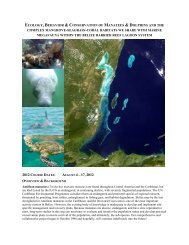Tribute to Dr. Akoi Kouadio - Sirenian International
Tribute to Dr. Akoi Kouadio - Sirenian International
Tribute to Dr. Akoi Kouadio - Sirenian International
Create successful ePaper yourself
Turn your PDF publications into a flip-book with our unique Google optimized e-Paper software.
• High protection for areas of high sirenian density migra<strong>to</strong>ry corridors<br />
• Buffer zones<br />
• Influence behavior of impacting communities including communities external <strong>to</strong> protected area<br />
• Protection at range of temporal and spatial scales<br />
• Advocacy<br />
• Co-management<br />
• <strong>Sirenian</strong>s as flagships<br />
• Livelihood <strong>to</strong> the local people.<br />
• Enhancement of cultural rights<br />
Threats <strong>to</strong> <strong>Sirenian</strong>s in Protected Areas:<br />
• Unsustainable <strong>to</strong>urism<br />
• Illegal hunting<br />
• Continued use of fishing gear that causes sirenian mortality and destroys habitat<br />
• Lack of continuous funding<br />
• Lack of connectivity between protected areas<br />
• Illusion of protection<br />
• Deleterious activities can influence the creation of protected areas<br />
• Failure <strong>to</strong> manage impacts outside the protected area<br />
• Political conflict between nation states<br />
• Lack of political will <strong>to</strong> manage the protected areas<br />
2. Features of a Protected Area that reduce the risk <strong>to</strong> sirenians in developing countries<br />
1. Community involvement that incorporates local knowledge<br />
2. Management plan that reflects legal framework and includes goals specific <strong>to</strong> sirenians<br />
3. Legal framework with political will <strong>to</strong> implement protected area<br />
4. Strong education and outreach program<br />
5. Protected Area network large enough <strong>to</strong> protect ecological processes and include a high proportion of<br />
the sirenian population throughout the year<br />
6. Long-term funding adequate <strong>to</strong> implement management plan<br />
7. Co-management involving government, NGOs, local communities and researchers<br />
8. Effective enforcement of management plan<br />
9. Capacity building including succession planning for all partners in the co-management arrangement:<br />
government, NGOS, community, researchers<br />
10. Management informed by active research program<br />
11. Alternative livelihoods for those community members affected by the implementation of the<br />
management plan<br />
Additional recommendations<br />
• Reduction of human-induced mortality <strong>to</strong> sirenians should be the highest priority for sirenian<br />
conservation.<br />
• Regional workshops and community level exchanges would provide valuable opportunities <strong>to</strong> exchange<br />
ideas.<br />
• Workshop on the challenge of eco<strong>to</strong>urism as an alternative livelihood would be timely.<br />
Sirenews No. 52 5 Oc<strong>to</strong>ber 2009













